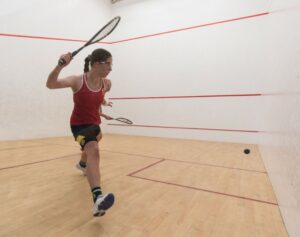A great piece by Tshepo Molefe
The few early stories about what is known as squash today indicate that in the early 1800 the ball was hit against any available wall in the front. The history of squash on WSF indicates that squash started with one wall in the front. Then side walls were introduced as players wanted to use whatever space that was available.
Initially it was played in the outdoors of schools like Harrow and prisons like Fleet Prison and Kings Bench Prison. With the popularity of the game it evolved and was played in a three wall structure and still outdoor. Due to inclement weather, players moved indoors. This is the beginning of squash being played indoors making it independent of the weather conditions outside.
In South Africa, as published on the Squash South Africa website “…squash was introduced early in the 20th century through the influence of the British military forces with the first courts being built at the Johannesburg Country Club and the Pretoria Squash Club. Squash rackets as it was known, was played mainly as an elitist sport at private schools and clubs but grew in popularity from 1925. In 1930 the court at the Johannesburg Country Club, which had been an open air one, was fitted with a roof and at the same time reduced to the conventional size court, as we now know them. Shortly thereafter, similar sized courts were built in Durban, Cape Town and Johannesburg….In 1910 South Africa became the first country in the World to form a national controlling body. The main function of this body was to administer the South African Championships”
After the covid pandemic, PSA did a survey on outdoor squash and a great majority of participants indicated that: they would enjoy to personally play outdoors; playing outdoors would increase club membership and; outdoor courts would increase awareness and knowledge of squash.
There are various options available currently on outdoor squash courts
Egoli has a mobile inflatable squash court. It has made squash accessible to the mass who have no access to the conventional courts.
There’s also outdoor squash courts by ASB and their price range is 80-360 000 euros.
Then there’s a simple wall design with a short back wall or without a back wall as built in Pakistan, USA etc
Three-wall structures are also great and less expensive to build and maintain.
This is something to be celebrated especially with #LA28! in mind and considering where and how Squash SA was founded.
Outdoor spaces can and should be used again as in the formation of the game of squash. There will be more mass participation. Kids can start picking up a racket as early as possible and this will help with their hand-eye coordination and wholesome development. The professional coaches and players can intervene to help with correct squash skills and etiquette but the rest of the time kids can develop and harness their individual personal skills by themselves.
One thing observed with Egoli is that the kids used to spend many hours in the court and that worked to their advantage. A professional someone came for an hour and the rest of the day kids worked themselves. So, visibility to the mass and easy access plus more hours in the court is a recipe for success.
Let’s celebrate #LA28 by going back to the basics to produce a winning team for South Africa.



